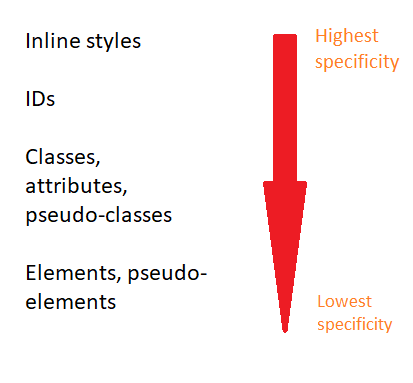Questions to consider
- Why are CSS naming conventions useful?
- When might Specificity become a problem?
- How can composition help us build UIs?
- Use hyphen Delimited string
e.g.
.redBox{...} (X)
.red-box{...} (O)
- The BEM naming convention - more structured naming convention // It is used for larger, more interrelated pieces of UI that require a number of classes
Hyphens for blocks - The sole root of the component Underscores for elements - A component part of the Block Double hyphens for modifiers - A variant or extension of the Block
- Do not bind your CSS and JS ooto the same class in HTML.
- It is much cleaner, more transparent, and more maintainable to bind JS onto specific classes
e.g.
<input type="submit" class="btn js-btn" value="Follow" />
- Know what a selector does, just by looking at its name (what type of thing a class does)
- have an idea of where a selector(class) can be used, just by looking at it
- know the relationships between class names, by looking at them
- CSS is difficult to maintain and keep stylesheets maintainable is important.
- By using CSS naming convention, code will always look and feel familiar to all members of the team, especially when is involved in big projects.
- The BEM approch ensures that everyone who participates in projects works with a single codebase and speaks the same language.
- Increase development speed, debugging and the implementation of new features in legacy code.
- To make stylesheets maintainable, I should keep code transparent, sane and readable
- Then I can keep my stylesheets scalable.
- Specificity is the means by which browsers decide which CSS property values are the most relevant to an element and therefore, applied.
- The browser uses the source order (i.e the cascade) of the CSS stylesheet to determine which CSS property values are the most relevant to apply to an element.
- This rule applies when the CSS selectors have equal specificity.
- The higher the specificity of a CSS selector, the more likely that browsers will apply its CSS declarations over another.
- No matter how well considered your naming, regardless of how perfect your source order and cascade are managed, and how well you’ve scoped your rulesets, just one overly-specific selector can undo everything.
- If I use hugely over-specific selector, it's trumping the specificity of the one defined later- working against CSS' source-order based application of styles.
- Then I will have to refactor my CSS and HTML or write a more specific selector to override it --> Think about time and cost!
- If I go with writing a more specific selector option, I will nedd another selector to override it.
- limit your ability to extend and manipulate a codebase
- interrupt and undo CSS' cascading, ingeriting nature
- cause avoidable verbosity in your project
- prevent things from working as expected when move into different environments
- lead to serious developer frustration
- try and keep specificity as low as possible at all times.
- make sure there isn't a lof ov variance between selectors in your codebase
- not using IDs in your CSS
- not nesting selectors
- not qualifying classes
- not chaining selectors
Questions to consider
- What is a NodeList?
- How is it different from an array?
- what's the difference between "live" and "static" NodeLists?
- What is the
<template>element?
- How can we use this to render dynamic UI?
- NodeList is a collection of nodes that can be used to access and manipulate DOM elements.
- NodeList usually retuend by properties such as
Node.childNodesand methods such asdocument.querySelectorAll(). - NodeList Properties:
NodeList.length - NodeList Methods:
NodeList.item(),NodeList.entries(),NodeList.forEach,NodeList.keys(),NodeList.values(). - Array is a JavaScript object which can hold more than one value at a time.
- Live NodeLists: Changes in the DOM automatically update the collection.
const parent = document.getElementById('parent');
let child_nodes = parent.childNodes;
console.log(child_nodes.length); // let's assume "2"
parent.appendChild(document.createElement('div'));
console.log(child_nodes.length); // outputs "3"
- Static NodeLists: Any changes in the DOM does not affect the content of the collection. The ubiquitous
document.querySelectorAll()method returns a static NodeList.
It's good to keep this distinction in mind when choosing how to iterate over the items in the Nodelist, and whether you should chche the list's length.
-
<template>element stores HTML markup but browser ignores this contents(only check if syntax is valid) -
HTML markup held by
<template>is not rendered immediately when a page is loaded. -
We can access and use HTML markup in JS. - access
template.contentfrom JS, clone it to reuse in a new component. -
(bonus) we can put styles and scripts into
<template>

